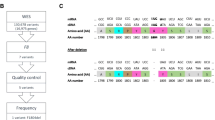Abstract
L1 sequences are a human-specific family of long, interspersed, repetitive elements, present as ∼105 copies dispersed throughout the genome1. The full-length L1 sequence is 6.1 kilobases, but the majority of L1 elements are truncated at the 5' end, resulting in a fivefold higher copy number of 3' sequences1. The nucleotide sequence of L1 elements includes an A-rich 3' end and two long open reading frames (orf-1 and orf-2), the second of which encodes a potential polypeptide having sequence homology with the reverse transcriptases1–4. This structure suggests that L1 elements represent a class of non-viral retrotransposons1,2. A number of L1 complementary DNAs, including a nearly full-length element, have been isolated from an undifferentiated teratocarcinoma cell line5. We now report insertions of L1 elements into exon 14 of the factor VIII gene in two of 240 unrelated patients with haemophilia A. Both of these insertions (3.8 and 2.3 kilobases respectively) contain 3' portions of the L1 sequence, including the poly (A) tract, and create target site duplications of at least 12 and 13 nucleotides of the factor VIII gene. In addition, their 3'-trailer sequences following orf-2 are nearly identical to the consensus sequence of L1 cDNAs (ref. 6). These results indicate that certain L1 sequences in man can be dispersed, presumably by an RNA intermediate, and cause disease by insertional mutation.
Similar content being viewed by others
References
Fanning, T. & Singer, M. F. Biochem. biophys. Acta (in the press).
Scott, A. F. et al. Genomics 1, 113–125 (1987).
Hattori, M. et al. Nature 321, 625–628 (1986).
Sakaki, Y. et al. Cold Spring Harb. Symp. quant. Biol. 51, 465–469 (1986).
Skowronski, J. & Singer, M. F. Proc. natn. Acad. Sci. U.S.A. 82, 6050–6054 (1985).
Skowronski, J. & Singer, M. F. Cold Spring Harb. Symp. quant. Biol. 51, 457–464 (1986).
Gitschier, J. et al. Nature 312, 326–330 (1984).
Toole, J. J. et al. Nature 312, 342–347 (1984).
Gitschier, J. et al. Nature 315, 427–430 (1985).
Youssoufian, H. et al. Nature 324, 380–382 (1986).
Antonarakis, S. E., Youssoufian, H. & Kazazian, H. H. Jr Molec. biol. Med. 4, 81–94 (1987).
Maniatis, T., Fritsch, E. G. & Sambrook, J. Molecular Cloning (Cold Spring Harbor, 1982).
Sanger, K., Nicklen, S. & Coulson, A. R. Proc. natn. Acad. Sci. U.S.A. 74, 5463–5467 (1977).
Mager, D. L., Henthorn, P. S. & Smithies, O. Nucleic Acids Res. 13, 6559–6575 (1985).
DiNocera, P. P. & Casari, G. Proc. natn. Acad. Sci. U.S.A. 84, 5843–5847 (1987).
DiNocera, P. P., Digan, M. E. & Dawid, I. B. J. molec. Biol. 168, 715–727 (1983).
Katzir, N. et al. Proc. natn. Acad. Sci. U.S.A. 82, 1054–1058 (1985).
Loeb, D. D. et al. Molec. cell. Biol. 6, 168–182 (1986).
Soares, M. B., Schon, E. & Efstratiadis, A. J. molec. Evol. 22, 117–133 (1985).
Adams, J. W. et al. Nucleic Acids Res. 8, 6113–6128 (1980).
Author information
Authors and Affiliations
Rights and permissions
About this article
Cite this article
Kazazian, H., Wong, C., Youssoufian, H. et al. Haemophilia A resulting from de novo insertion of L1 sequences represents a novel mechanism for mutation in man. Nature 332, 164–166 (1988). https://doi.org/10.1038/332164a0
Received:
Accepted:
Issue Date:
DOI: https://doi.org/10.1038/332164a0
- Springer Nature Limited
This article is cited by
-
Proceedings of the inaugural Dark Genome Symposium: November 2022
Mobile DNA (2023)
-
Transposable elements as essential elements in the control of gene expression
Mobile DNA (2023)
-
The interferon stimulated gene-encoded protein HELZ2 inhibits human LINE-1 retrotransposition and LINE-1 RNA-mediated type I interferon induction
Nature Communications (2023)
-
The composition dynamics of transposable elements in human blastocysts
Journal of Human Genetics (2023)
-
A human-specific insertion promotes cell proliferation and migration by enhancing TBC1D8B expression
Science China Life Sciences (2023)





